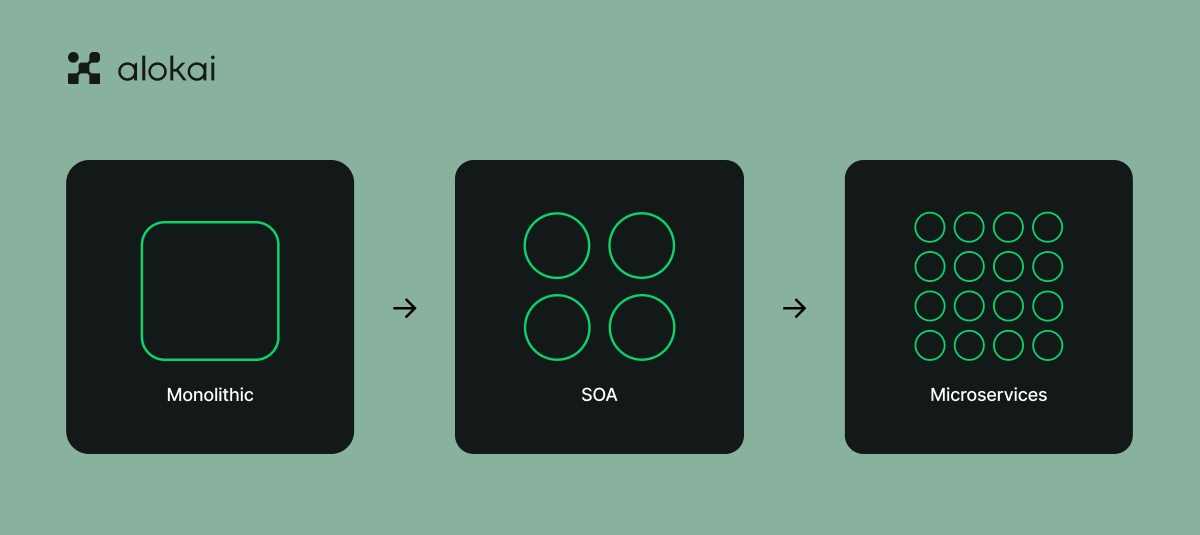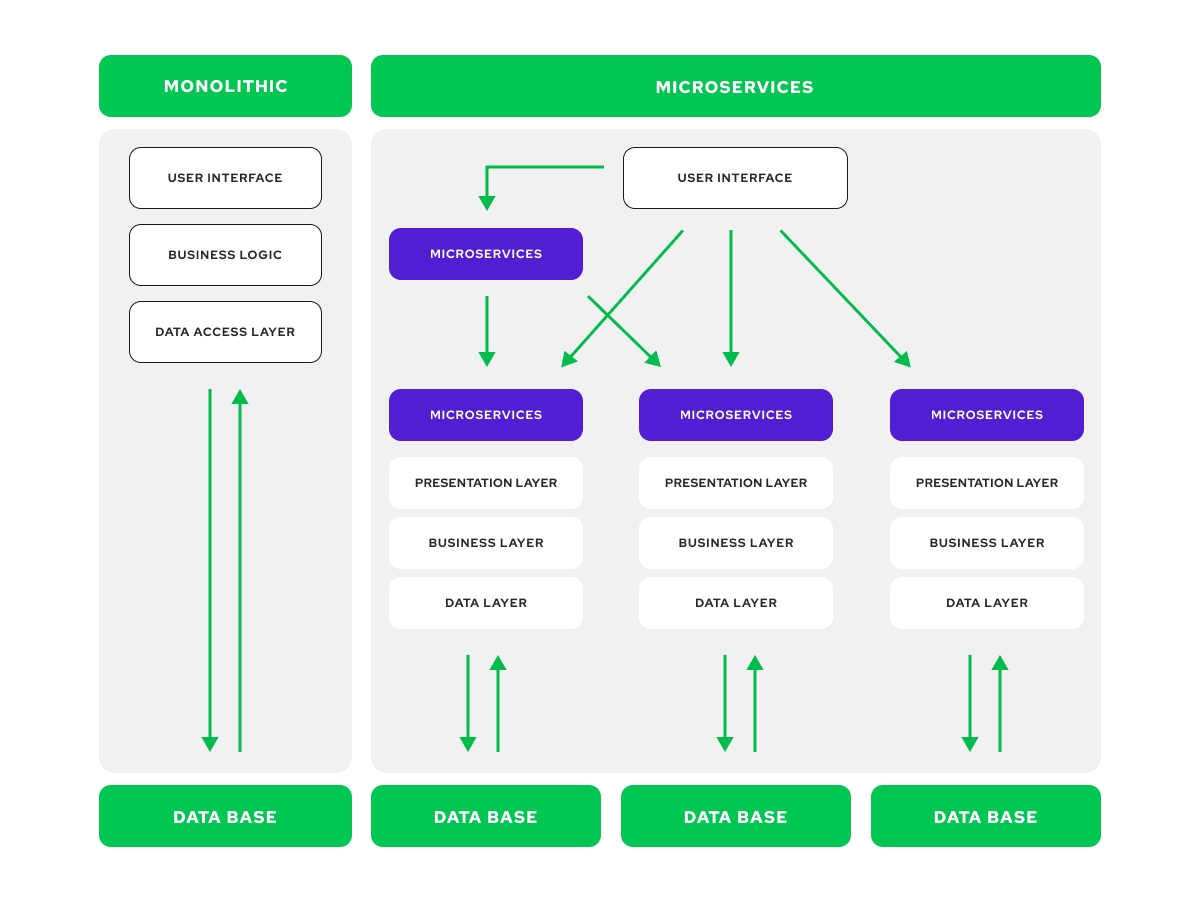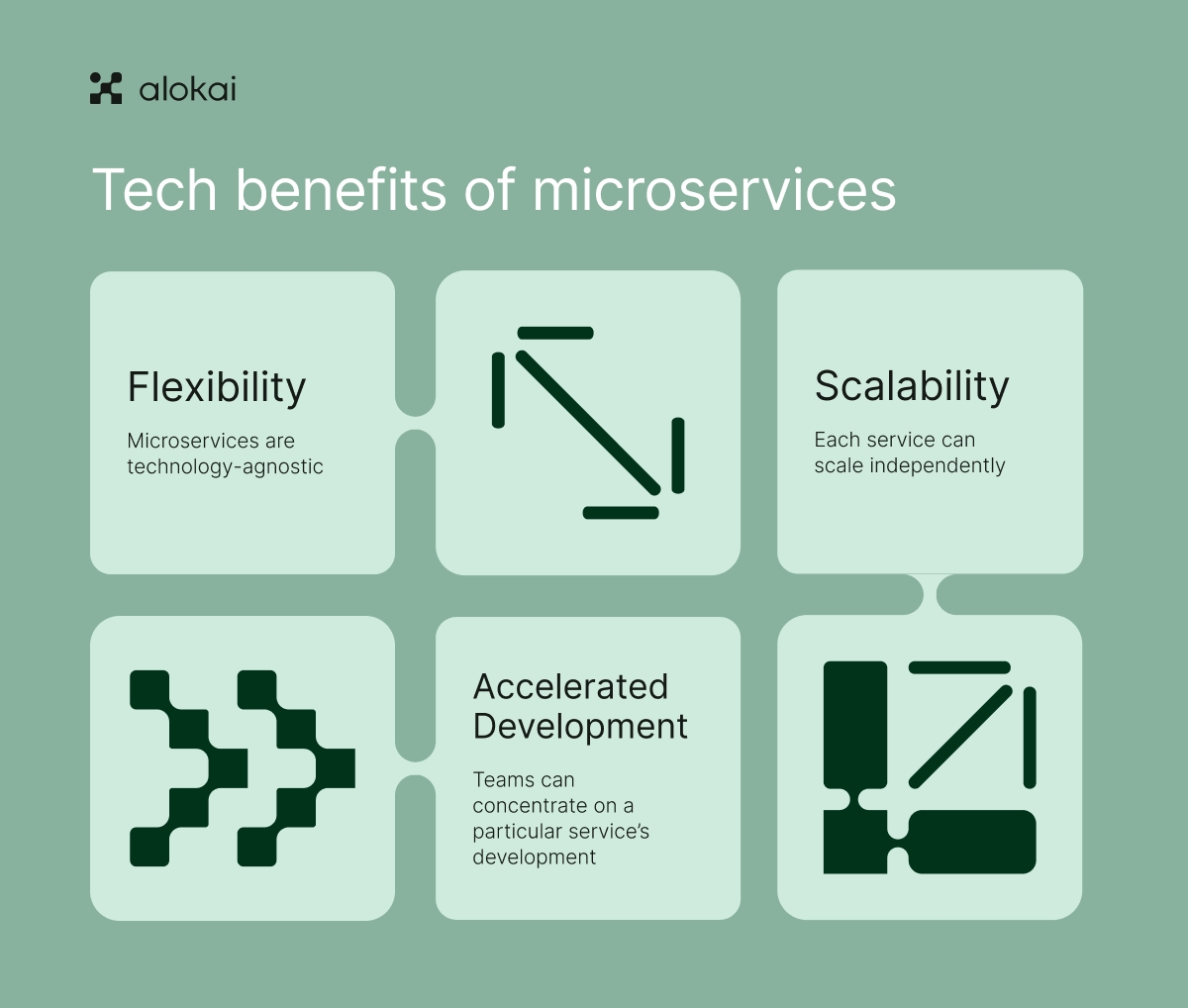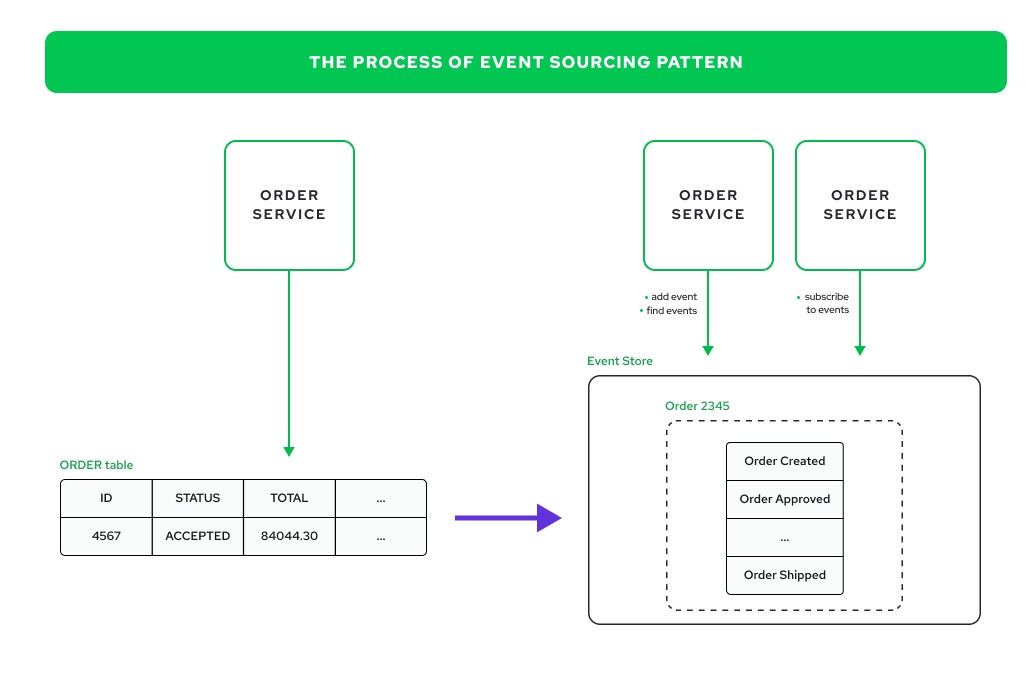Deciding between microservice vs SOA (Service-Oriented Architecture) is crucial for modern software development. This article will break down their main differences, advantages, and challenges, helping you determine which fits your requirements best.
Key Takeaways
- Service-oriented architecture (SOA) and microservices both aim to decompose monolithic applications into modular services. Still, SOA focuses on enterprise-wide integration with centralized management, while microservices emphasize independent, single-purpose services with decentralized governance.
- Microservices offer advantages like rapid deployment, fault isolation, and agility in updating specific components. However, they introduce challenges such as intricate service communication and increased resource demands; SOA, on the other hand, excels in scalability and interoperability but can suffer from complexity and tight coupling.
- Organizations can benefit from hybrid architectures that combine SOA’s robust integration capabilities with the agile, scalable nature of microservices. These architectures enable a balanced approach to meeting diverse business needs and facilitate gradual transitions.
Microservice vs SOA: A Clear Comparison for Modern Architecture

Once upon a time, in the late 1990s, a concept known as SOA emerged. It sought to untangle the monolithic applications of the day by breaking them up into modular, reusable, and discoverable services, each with its own unique role within the business ecosystem. Fast-forward to today SOA has evolved into a mature framework that orchestrates these modular services to support complex business operations and enterprise deployments.
Parallel to the SOA narrative, a new protagonist entered the stage: microservices. This contemporary architectural style structures applications as a collection of distinct, single-purpose services, emphasizing autonomy and decentralized governance. This contrasts with SOA’s broader enterprise scope and more centralized service management.
While SOA and microservices aim to create a tapestry of interconnected services, they weave their patterns with different threads, each with its own advantages and challenges to suit diverse software landscapes.
Introduction
The term ‘microservices’ has vaulted from being just a buzzword to an essential staple in the software development diet. Casting a critical eye on the monolithic architecture of yesteryears, developers recognized the pitfalls of tightly integrated systems that stifled independent deployment and evolution of system components. In response, both microservices and SOA have stepped up, championing the breaking down of large, cumbersome applications into smaller, more manageable pieces that could dance to the tune of ever-changing business requirements.
What truly sets these two apart is not just their design philosophy but also their operational characteristics. Microservices architecture, heavily inspired by its predecessor SOA, spins a web where each service operates within its own bounded context, laser-focused on a specific business capability. This thereby simplifies the user interface and enhances overall system resilience. It’s a tale of evolution, where the lessons learned from SOA paved the way for the rise of microservices, each reflecting different stages of architectural maturity and innovation.
Understanding Service-Oriented Architecture (SOA)
SOA presents a grand vision—a software development approach where applications are built and orchestrated, harmonizing each service module to fulfill specific business objectives. This symphony of services is not confined to a single application; rather, it transcends individual systems to benefit the entire enterprise.
This ability to integrate and interact across different services, bound by common communication standards and an enterprise service bus, makes SOA a cornerstone of modern business operations and software development.
Service provider
In the SOA ensemble, the service provider plays a pivotal role, akin to a maestro defining the terms of use and ensuring that the services offered are accessible and discoverable to the rest of the orchestra.
Through the use of various communication standards, such as:
- HTTP
- SOAP
- Java Messaging Service
- Advanced Messaging Queuing Protocol (AMQP)
- MSMQ
The service provider ensures that different services, including functional services and individual services, are not just standalone performers but integral parts of a cohesive performance, achieved through component sharing.
Service repository
Acting as a central catalog, the service repository in SOA is akin to a library that houses the details of available services, empowering service consumers to seamlessly discover and bind to the services they require. It is in this repository where service providers store their web services, making them available for use and reuse, a crucial part of the SOA fabric that enables a dynamic and flexible apps infrastructure.
Service consumer
On the opposite end, we have the service consumer, a component that:
- Locates and utilizes the services laid out by the provider
- Is the seeker of the SOA world, navigating through the service registry
- Identifies the right services for the task
- Binds to them to fulfill its purpose within the enterprise’s business processes.
Exploring microservices architecture
Microservices architecture takes a different approach from SOA, focusing on dividing an application into a suite of small, independent services. Each microservice is a self-contained unit, responsible for a specific business function, and operates autonomously, communicating with other services through well-defined interfaces.
This separation into independent services ensures that each microservice can be developed, deployed, and scaled in isolation, embodying the principles of agility and flexibility that are hallmarks of cloud-native architectural approaches when deploying apps infrastructure services.
Independent services
The independent nature of microservices is both their strength and their uniqueness. By structuring the application as a collection of loosely coupled services, each microservice can be replaced, upgraded, or scaled without affecting the rest of the system. This independence is further enforced by deploying services in containers, which enhances their scalability and portability, allowing each service to be a self-sufficient unit within the larger ecosystem.
Communication protocols
When it comes to communication, microservices opt for simplicity and efficiency. They employ lightweight communication protocols, such as RESTful APIs and Simple Object Access Protocol, to handle requests and responses between services. This approach avoids the complexity of an enterprise service bus, instead favoring direct interactions that are both agile and scalable.
Decentralized data storage
The decentralized data storage of microservices is a testament to their autonomy. Each service manages its database, allowing for a more flexible and independent approach to data management. This Polyglot Persistence model enables services to utilize different database technologies best suited to their specific needs, distinguishing microservices from the centralized data governance in SOA. However, implementing consistent data governance across these decentralized systems is crucial for maintaining data integrity and compliance.
Key differences between SOA and microservices

At the heart of the debate between SOA and microservices lies a few key differences that set them apart. SOA, with its enterprise-wide scope, offers a centralized system designed for integration and coordination between various services. In contrast, microservices embrace a decentralized model, prioritizing the independence of each service and minimizing shared resources to foster agility and resilience.
When it comes to service granularity, SOA services are more coarse-grained, encompassing broader functionalities that can be used across different applications. Microservices, on the other hand, are fine-grained, each tailored to fulfill a specific business function. This fundamental distinction in service design carries through to deployment strategies, where SOA’s more coupled nature can complicate deployments, while microservices’ independent nature enables rapid, scalable deployments in a cloud environment.
Centralization vs decentralization
The tug-of-war between centralization and decentralization is a defining feature of the SOA and microservices comparison. SOA, with its centralized data storage and governance, necessitates high coordination and can encounter coupling issues, whereas microservices, free from the confines of a centralized enterprise service bus, offer a more modular and resilient architecture.
Service granularity
The finer details of service granularity reveal SOA’s preference for larger, more comprehensive services. Microservices, in contrast, are designed to be as focused and granular as possible, enabling them to be highly cohesive and optimized for specific capabilities.
Data management
Data management is yet another battleground for these architectural styles. SOA often relies on a single data storage layer, shared among connected services, while microservices advocate for independent data storage, with each service managing its own database, promoting autonomy and reducing the risk of cascading failures.
Deployment strategies
Deployment strategies also diverge significantly between SOA and microservices. SOA’s deployments are often larger and more complex, sometimes requiring an enterprise service bus to manage them.
On the other hand, microservices can be deployed independently and scaled on-demand, making them well-suited for dynamic cloud environments and continuous delivery models.
Advantages and disadvantages
Each architectural style comes with its own set of advantages and disadvantages that can sway decision-makers. SOA’s reusability, scalability, and interoperability make it an attractive option for large enterprises that require robust integration between diverse systems. However, the tight coupling and complexity of managing such a system can be significant drawbacks, especially when it comes to maintenance and flexibility.
Microservices, in their agile splendor, offer quick deployment, fault isolation, and independent scaling, which can be highly beneficial for organizations seeking rapid innovation and frequent updates. Yet, their distributed nature introduces complexities in system management, data consistency, and increased resource demands, which can be challenging to navigate without adequate planning and tools.
Benefits of SOA
SOA boasts several benefits that make it appealing for certain use cases:
- Its ability to reuse services across multiple applications can lead to significant efficiencies and cost savings.
- Its scalability and interoperability are crucial for enterprises that manage complex, transaction-heavy applications.
- Its adaptability enables organizations to respond swiftly to market changes.
Drawbacks of SOA
On the flip side, SOA can be quite the beast to tame, with its complex interdependencies creating a tangled web that’s difficult to modify or debug. Tight coupling can lead to brittle architectures, and the centralized governance model can be resource-intensive.
Moreover, the reliance on an enterprise service bus can introduce a single point of failure, and the performance of SOA can suffer from the overhead associated with service communications, especially when dealing with complex business operations enterprise services.
Benefits of microservices

Microservices excel at fostering innovation and speed. Their independent deployment cycles allow for continuous improvement without system-wide downtimes. One of the benefits of microservices architecture is the alignment with agile development principles enables teams to fully own their services, from development to production.
Fault isolation ensures the entire system remains robust, and containerization offers streamlined scalability.
Drawbacks of microservices
However, microservices are not without their challenges. Some of the challenges include:
- Intricate service communications due to their distributed nature
- The need for extensive monitoring and logging
- Complicated management
- Distributed data and transactions requiring thoughtful strategies to maintain consistency
- Version control becoming a headache when coordinating multiple services
- Additionally, the need for more computing resources can drive up costs.
Practical use cases
Choosing between SOA and microservices is not merely a matter of preference but one of practicality, determined by specific scenarios and organizational needs. SOA’s centralized and integrative nature suits large-scale enterprises dealing with complex systems and legacy applications, while microservices’ agility and ease of deployment are ideal for fast-moving companies that prioritize innovation and scalability.
When to choose SOA
Opting for SOA makes sense for organizations that:
- Have a mix of legacy and standalone applications that must operate cohesively within a larger framework
- Cannot afford disruptions but require a stable, scalable, and interoperable infrastructure
- Need to integrate and modernize systems incrementally
SOA’s ability to meet these needs is a boon for companies.
When to choose microservices
Conversely, microservices are a match for environments that demand continuous delivery and rapid iteration, such as start-ups and tech companies. These architectures support frequent, independent updates, allowing different parts of an application to evolve without downtime.
They also offer the flexibility to scale services dynamically, making them suitable for cloud-native applications where rapid development and deployment are paramount, especially when using apps infrastructure services.
Integration and coexistence

While SOA and microservices might seem like rival factions, they can, in fact, coexist harmoniously within the same organizational landscape. SOA can serve as the backbone for enterprise-wide integration, tackling larger, more complex service components, while microservices can handle more focused functionalities that benefit from rapid development cycles. Together, they can provide a robust yet flexible infrastructure that leverages the strengths of both architectures.
Hybrid architectures
In the real world, many organizations find value in adopting a hybrid architecture combining SOA and microservices elements. This approach allows for integrating complex, reusable services under the SOA umbrella with microservices' quick deployment and independent scaling capabilities. It’s a strategic blend that can cater to a wide spectrum of business needs, striking a balance between robustness and agility.
Transition strategies
A measured, phased approach is key for enterprises looking to transition from one architecture to another. Organizations can gradually decouple and migrate to microservices starting with less critical services, ensuring minimal disruption to core functionalities.
Establishing clear boundaries and maintaining independence between services is crucial to avoid creating new dependencies that can lead to a monolithic-like complexity.
Summary
As we’ve navigated the intricate landscapes of SOA and microservices, it’s clear that each architectural style possesses unique characteristics suited for different organizational needs and objectives. Whether seeking enterprise-wide integration with SOA or aiming for agility and rapid deployment with microservices, understanding their advantages and limitations is paramount. The journey from monolithic structures to service-oriented and microservice architectures reflects the evolving nature of software development, where flexibility, scalability, and resilience are the keys to navigating the complexities of modern business.
